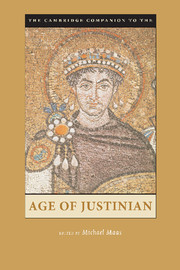Book contents
- Frontmatter
- Part 1 Structures and Ideologies of Empire
- 1 Roman Questions, Byzantine Answers
- 2 Economy and Administration
- 3 Justinian’s Constantinople
- 4 The Classical City in the Sixth Century
- 5 The Empire at War
- 6 Mediterranean Plague in the Age of Justinian
- 7 Law and Legal Practice in the Age of Justinian
- 8 Justinianic Ideology and the Power of the Past
- Part 2 Religion and Philosophy
- Part 3 Literature and the Arts
- Part 4 Peoples and Communities
- Bibliography
- Index
- Plate Section 1
- Plate Section 2
3 - Justinian’s Constantinople
from Part 1 - Structures and Ideologies of Empire
Published online by Cambridge University Press: 28 May 2006
- Frontmatter
- Part 1 Structures and Ideologies of Empire
- 1 Roman Questions, Byzantine Answers
- 2 Economy and Administration
- 3 Justinian’s Constantinople
- 4 The Classical City in the Sixth Century
- 5 The Empire at War
- 6 Mediterranean Plague in the Age of Justinian
- 7 Law and Legal Practice in the Age of Justinian
- 8 Justinianic Ideology and the Power of the Past
- Part 2 Religion and Philosophy
- Part 3 Literature and the Arts
- Part 4 Peoples and Communities
- Bibliography
- Index
- Plate Section 1
- Plate Section 2
Summary
Constantinople, Monday, August 11, 559. An unusual event is unfolding in the coolness of the early morning. Justinian and his vast entourage of officials, servants, packhorses, and carts are assembling outside the walls of the imperial capital, by the Gate of Charisius. They are returning from Selymbria (modern Silivri), about sixty-five kilometres to the west, along the coast by the Sea of Marmara. Justinian, now in his late seventies, has been emperor for over thirty years. In all that time he has hardly set foot outside Constantinople. For the past few months, however, the aged sovereign and his court have been residing at Selymbria for extraordinary and urgent reasons. They had been engaged in the restoration of the Thracian Long Wall, which ran for sixty kilometres across the full length of the peninsula and constituted the outer defences of the capital. The wall had been seriously damaged in an earthquake in December 557 and later overrun by a menacing band of Cotrigur Huns. Justinian’s veteran general Belisarius had been dispatched to repulse the Huns, and the ensuing peace facilitated the imperial expedition to Selymbria. The emperor’s return to Constantinople in August 559 was announced and orchestrated. This was the traditional rite of welcome to a Roman city, the adventus. On entering the city he was formally greeted by the city prefect and other dignitaries, then ritually acclaimed by the Blue and Green circus factions in their colorful billowing costumes.
- Type
- Chapter
- Information
- The Cambridge Companion to the Age of Justinian , pp. 60 - 86Publisher: Cambridge University PressPrint publication year: 2005
- 9
- Cited by

